8 fiberglass cars that made plastic fantastic
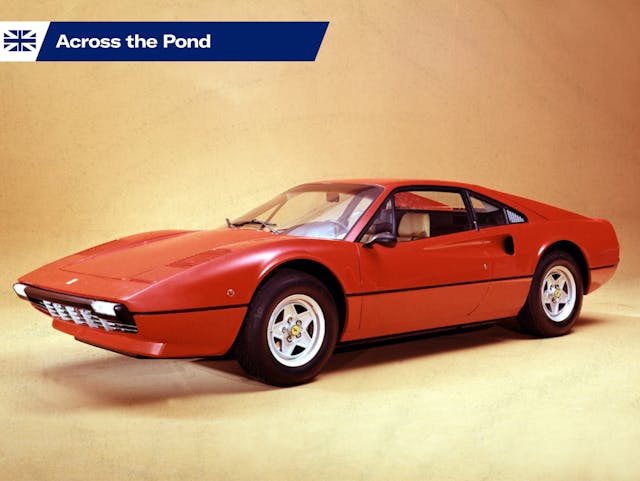
The Corvette may be the most popular fiberglass-bodied car by volume, but it wasn’t the first—and it certainly isn’t the most exotic. Have a read of this list, compiled by our U.K. colleagues, and reinforce your belief in the fantastic possibilities of plastic. —Ed.
Though the British motor industry has been doing fantastic things with plastic for around seven decades, the history of fiberglass body construction goes back even further. In his excellent book Excess All Areas: British Kit Cars of the 1970s, Richard Heseltine charts the use of fiberglass in the United States, kickstarted in 1936 by the Owens-Illinois glass company and its pioneering use of continuous fibers of glass, using the trade name Fiberglas.

Five years later, Henry Ford unveiled the Soybean Car (above), which utilized 14 plastic panels attached to a steel tubular frame. According to The Henry Ford Museum of American Innovation, the body’s ingredients included soybeans, wheat, hemp, flax and ramie.
Today, the use of fiberglass is synonymous with the British specialist and sports car industries, but it’s a truly global affair.
1953 Chevrolet Corvette

The American Bill Tritt had been building fiberglass boats for two years when he was approached by friend Major Ken Brooks. Tritt was tasked with creating a European-style roadster based on the chassis of an old Willys Jeep, in which Brooks’ wife refused to travel. The result was the Brooks Boxer, which became the Glasspar G2, a car credited as being the world’s first fiberglass sports car.
Tritt went on to design and build fiberglass cars for a range of companies, but his role in the creation of the Chevrolet Corvette is often overlooked. The G2 was presented to Harley Earl, General Motors’ vice-president in charge of styling. For Earl, it was a source of inspiration; the use of Glass-Fiber-Reinforced Plastic (GRP) would save money on tooling while underlining the Corvette’s position as the American sports car of the future.
GM’s promotional material extolled the virtues of the Corvette’s “two-passenger, open-cockpit body of glass-fiber reinforced plastic; light, strong, durable, rustproof, quiet and easy to repair.” For New Yorkers at the 1953 Motorama, plastic truly looked fantastic. And so began seventy years of series production.
1958 Jensen 541
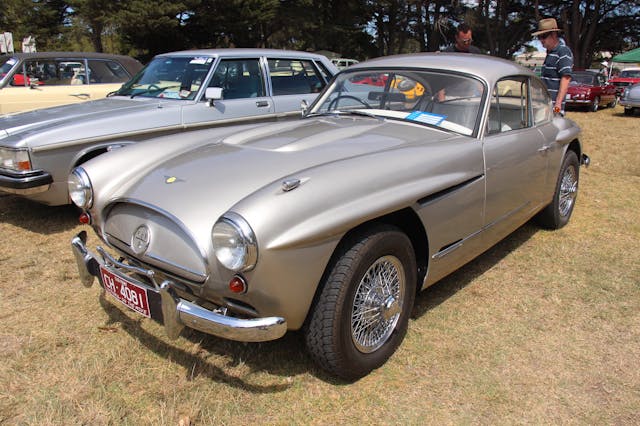
On the other side of the Atlantic, Jensen was readying the world’s first four-seater car—and Europe’s first series production performance car—with a fiberglass body. The combination of a 4.0-liter straight-six engine and lightweight, aerodynamic body made it one of Britain’s fastest cars of the 1950s.
Jensen remained faithful to fiberglass construction with the 541R (pictured), 541S, and C-V8, before the arrival of the Interceptor in 1966 saw a return to a steel body shell.
1961 Lotus Elite
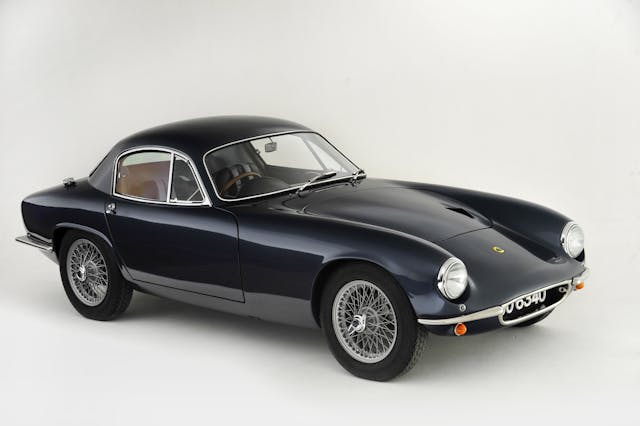
The Lotus Elite was one of the most revolutionary and significant cars of the 1950s. Unlike the Corvette, whose fiberglass panels were mounted on a separate chassis, the Elite featured a monocoque built entirely of fiberglass. This was the first time fiberglass had been used for the whole load-bearing structure of the car. The result was a car that weighed about the same as a bag of sugar, with a drag coefficient of just 0.29—in 1957!
The first 250 bodies were built by Maximar Mouldings of West Sussex, before quality issues saw the work being handed to the Bristol Aeroplane Plastics Limited. In an advertisement, Bristol called it “the most advanced car body ever built.” The copywriter probably had a point.
1958 TVR Grantura
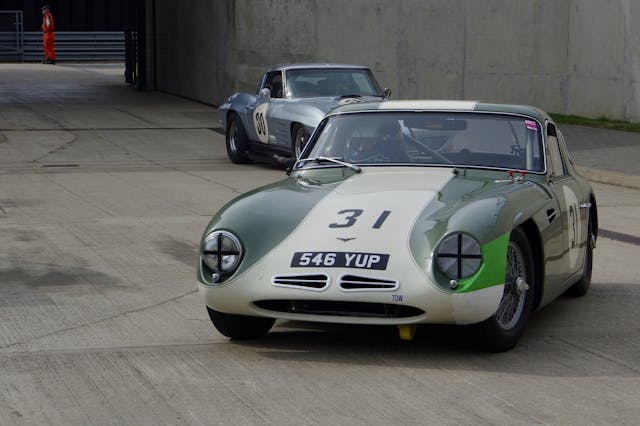
A list of fiberglass cars wouldn’t be complete without a TVR, so it makes sense to feature the marque’s first production vehicle. The Grantura of 1958 featured a fiberglass body molded to TVR’s own tubular steel chassis, with the trailing arms and torsion bars from a Volkswagen Beetle.
Other components shipped in included the windscreen from a Ford Consul and the drum brakes from an Austin-Healey 100, along with a choice of engines sourced from Coventry Climax, Ford, and BMC.
1959 Daimler SP250
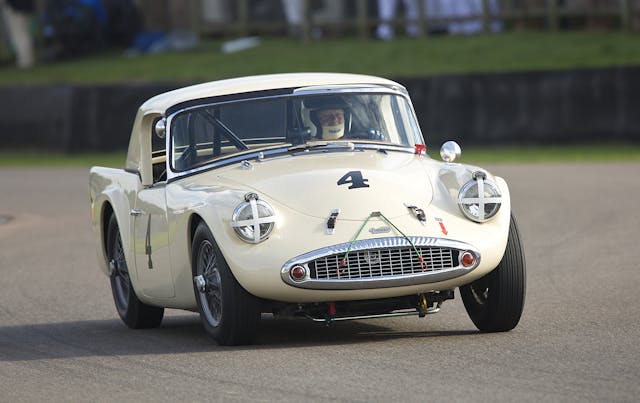
In some ways, the Daimler SP250 was the British Corvette. Launched as the Dart at the 1959 New York motor show, Daimler was forced to change the name to SP250 following a trademark complaint from Dodge.
Slow sales meant that the V-8-engined SP250 was the last hurrah for Daimler; the company was bought by Jaguar in 1960, before the axe fell on the sports car in 1964.
1970 Bond Bug
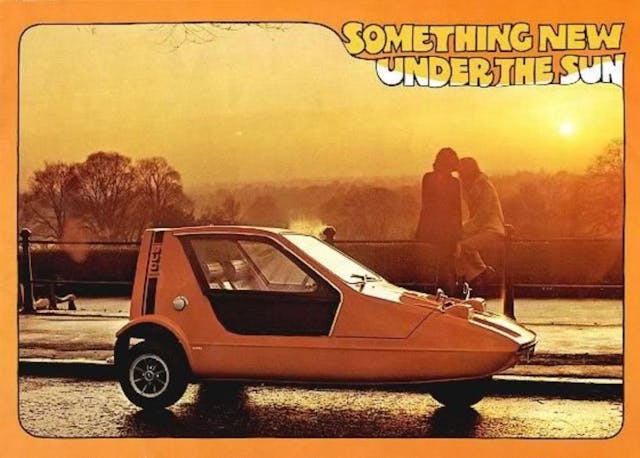
In an interview published in Classic.Retro.Modern. magazine, design genius Tom Karen named the Bond Bug and Marble Run as the two products of which he is most proud. With its orange paintwork, wedge shape, and black decals, the Bug is one of the most 1970s cars of the 1970s. In other news: It’s too long since we played Marble Run.
The brochure delivered a gloriously informal assessment of the benefits of a fiberglass body: “Rap the side of the Bug with your knuckle. There is no hollow, tinny sound; it gives a deep, solid thunk-thunk-thunk. The body of the Bug is made not of metal but of tough, reinforced glass fibre. There is a big advantage to you; because glass fibre cannot rust.”
Makes you thunk, doesn’t it?
1975 Ferrari 308 GTB
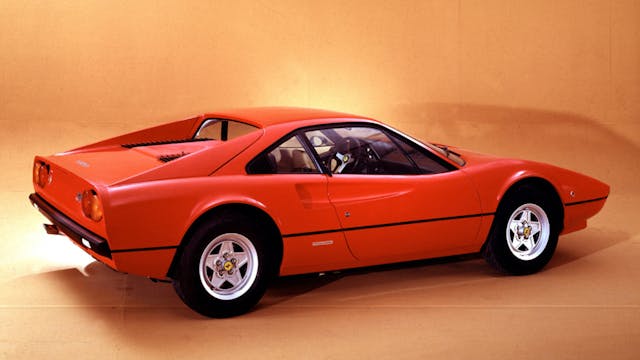
Many car names sound better in Italian: Quattroporte (four doors), Topolino (little mouse), Scuderia (stable), and Testarossa (redhead). So, it’s no surprise that the Ferrari 308 GTB “Vetroresina” sounds more exotic than the 308 GTB “Fiberglass.”
This was the first production Ferrari to feature a fiberglass body, but why did Maranello shift from steel? Probably because Ferrari needed to fast-track the development of a new car in response to the slow-selling 308 GT4. The subject of weight also played a part, while some historians speculate that Ferrari used fiberglass in case the car didn’t sell.
By late 1976, just a year after the 308 GTB made its debut at the Paris motor show, cars were arriving in the U.S. wearing steel bodies, although fiberglass cars remained on sale in Europe until the middle of 1977. Various reasons have been tabled for the switch from plastic to steel, including difficulty in finding specialists to repair accident damage, construction that was more labor-intensive than envisioned, and even the fact that fiberglass was never anything other than a temporary measure.
1977 Matra Rancho
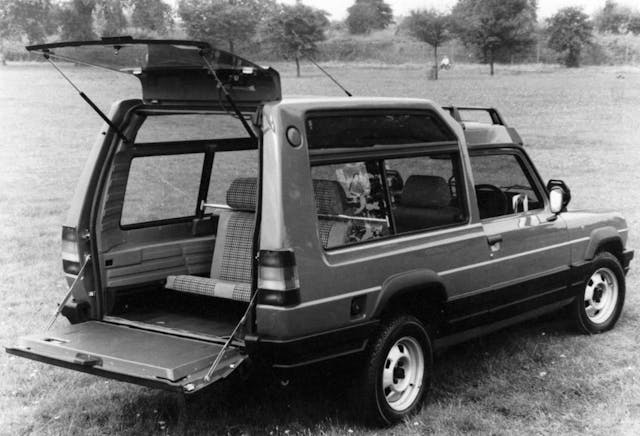
Forget all the nonsense about the Nissan Qashqai being the first crossover. Plenty of other manufacturers had previously attempted to blaze the trail, most notably the Matra Rancho of 1977.
Built to satisfy the needs of would-be Range Rover owners who wanted to talk the talk, but didn’t necessarily need to walk the walk, it pioneered the concept of a rough and ready SUV without the ability to venture further off-road than a dropped curb on the Kings Road.
The fiberglass rear section was mounted on a steel frame, the rusting of which doomed too many examples of the radical oddball. Matra stayed true to fiberglass construction with the development of the Renault Espace.
The others

There are countless other fiberglass cars we could have included. The Lancia Stratos, Citroën Bijou, Gilbern Invader, AC 3000ME, Clan Crusader, Vauxhall VX220, and Reliant Scimitar, to name just a few.
A separate list could feature more plastic creations from TVR and Lotus, not to mention the myriad kit cars produced during the boom in self-build vehicles. But before we further extol the virtues of the body material, read how difficult it can be to properly restore a fiberglass body.
Check out the Hagerty Media homepage so you don’t miss a single story, or better yet, bookmark it.


Looks like we need 8 More Fiberglass Cars Part II, III, etc.
My beloved 1974 Saab Sonett III (last year of production) has some styling that still looks futuristic today. And it’s all glass.
And of course there is Saturn with plastic body panels.
Bricklin
Elva Cars made the first Courier in 1958. I have #122 made in 1960 and I am the only orginal owner of an Elva.
YOU FORGOT THE T BUCKET……
Four fiberglass-bodied two-seater sports cars came from SAAB in Sweden: The SAAB 94, AKA Sonett I, six produced between 1955 and 1957, with fiberglass body over aluminum alloy box frame. Followed in 1966 by SAAB 97 (Sonett II) with fiberglass body over steel box-type frame, then Sonett V4 from 1967-70 and Sonett III from 1970-74.
Lots of comments about those not listed, but little talk of those that were. I’ve owned several Daimler SP250’s over the years. Amazingly fast, with a silky smooth hemi-head V-8 well ahead of it’s time. And with 4 wheel disk brakes no less in 1959-60. The car had it’s share of faults, not the least a single pot brake system, that when it failed, left you with absolutely without brakes at all. Found that out in Pullman, Wa heading downhill into the busyiest intersection in town at 5pm. Unscathed, but still a brown seat memory!
Take a look at the Jay Leno video of his restoration of one. He couldn’t get the smile off of his face. Nothing like a 2000 lb car with a hemi to get you going!
Whoever said that the Qashqai was the first crossover. Matravers sure…but with 4wd you also had the Golf Country and Panda 4×4.
The sliding doors on the Kaiser Darrin should have been enough to warrant a mention in the article. That feature alone made plastic fantastic!
The Saab Sonnet. Sturdy fiberglass didn’t even crack when I struck a deer in mine on a nighttime drive.
I was looking for the Avanti, I own one but there is another car missed on that list.
The Woodill Wildfire was an American sports car built by Dodge and Willys dealer Blanchard Robert “Woody” Woodill from 1952 to 1958 in Downey, California. The Wildfire used a Glasspar fiberglass body and is credited with being the first complete fiberglass car available with approximately 15 produced and another 285 sold as kits. A child’s version of the vehicle called the Brushfire was also available.
Being fair, I’m sure there are others that should/could be on that list but the article wasn’t presented as an all inclusive list. Good read anyway. Thanks.
I know a few people mentioned it already, but how could the Studebaker Avanti (introduced as a 63 model) be overlooked?
Don’t forget the iconic Saab Sonett.
From where I am sitting right now, I can see a red (Red Sail lacquer) Kaiser Darrin, a metallic gold Glaspar G2, a C1 Corvette (Polo White, of course), and an Avanti White Avanti. Not to mention the ‘59, ‘63, and ‘69 ‘Vettes. If you’re ever in Memphis, come see us at the Edge Motor Museum.